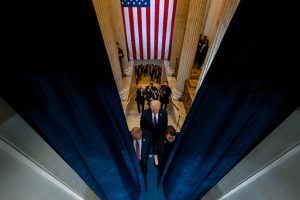Crypto exchange Binance, which is facing scrutiny of US regulators, maintained control of bank accounts belonging to its US arm, even as it claimed it was independent, bank records and and internal company messages show.
A senior Binance executive, close to CEO Changpeng Zhao, was the main operator for five bank accounts belonging to Binance.US, including an account that held American customers’ funds, bank records show.
Employees at the Binance affiliate had to ask the executive’s team to process payments, even to cover the firm’s payroll, company messages show.
Also on AF: Global Watchdog Unveils Regulatory System For Crypto Sector
The findings come at a time when Binance’s US operations are facing ever-closer attention in Washington.
They offer further detail into how Binance exercised tight control over Binance.US, despite both firms maintaining that they have always operated independently.
The previously unreported bank records and messages show that Binance’s management over the US business’ finances extended across its bank accounts at collapsed US lender Silvergate Bank and detail how this secret access was granted.
They also show how by secretly retaining control over Binance.US’s finances, Zhao ensured he could direct the company’s expansion in the American crypto market – one of the world’s biggest – while keeping it apart from his global exchange that was under scrutiny from US regulators.
The US Commodity Futures Trading Commission charged Binance and Zhao in March with willful evasion of commodities laws by “intentionally structuring entities” to avoid US regulations designed to protect investors.
Zhao called the civil charges an “incomplete recitation of facts.”
‘Primary Admin User’
The Binance.US trading platform was launched by its operating firm, BAM Trading, in mid-2019 under chief executive Catherine Coley. Zhao owned BAM Trading through layers of offshore companies, company documents show.
But Binance.US said it operated solely as a “US partner” of Binance. Reuters reported last year that, in fact, Zhao created Binance.US as a de-facto subsidiary to draw US regulators’ scrutiny away from the global exchange.
In December 2019, a Binance.US employee told Coley that Silvergate wanted her to sign a banking resolution, a document that defines a firm’s banking relationship, to “make sure it is ok” for Guangying Chen, a Binance executive close to Zhao, to manage Binance.US’s bank accounts, messages exchanged between Binance.US employees show.
The resolution document, reviewed by Reuters and authored by a Silvergate relationship manager, requested that Coley authorize Chen to “open accounts, transact, and otherwise operate” accounts on behalf of BAM Trading. A person familiar with the document said Coley signed it.
Also on AF: Binance Stablecoin Chalks up $6bn of Outflows After US Crackdown
Coley left Binance.US in 2021. A lawyer representing her, James McDonald, didn’t respond to requests for comment.
Chen then signed further agreements with Silvergate to act as the “Primary Admin User” for the five bank accounts: a customer deposit account, an account for corporate clients, and three other accounts, according to bank records dated between December 2019 and January 2020. The agreements said the authorized person could withdraw funds from the accounts or deposit them, and designate others to do so, too.
Earlier this year, banking records and company messages showed that a deputy of Chen’s had access to one of those accounts — that for corporate clients — and that the account transferred more than $400 million in 2021 to a trading firm controlled by Zhao.
Binance.US said then that the trading firm, Merit Peak, was withdrawing its own funds, money that derived from its trading activity on the exchange.
Last month, sources also said Binance mixed its customers’ funds with its corporate revenues in Merit Peak’s Silvergate account, in breach of US financial rules that require client money to be kept separate.
Binance denied mixing customer deposits and company funds, saying that users who sent money to the account were not making deposits but rather buying Binance’s bespoke dollar-linked crypto token.
“We cannot change anything”
In 2020, Coley told colleagues in a message that she and her finance team were not administrators for BAM’s accounts and only had view-access.
The arrangement left Binance.US’s chief lacking ultimate control over the company’s own finances. “We cannot change anything” in the Silvergate banking portal, she wrote.
Meanwhile, Krishna Juvvadi, the head of legal at Binance.US, said in April that employees of Binance.US’s operator, BAM Trading, had “exclusive control” since its founding in 2019. He denied that Binance ever operated its bank accounts.
In response to questions for this article, however, a Binance.US spokesperson, Christian Hertenstein, said that since the company’s current chief executive, Brian Shroder, took over in late 2021, “no one other than Binance.US officials have had control or access to Binance.US accounts.” Hertenstein did not explain the discrepancy in the time periods given by him and Juvvadi.
Hertenstein added that “since at least 2021, the only ‘Primary Admins’ on active Binance.US accounts have been Binance.US officials.” He said some of the accounts identified as being operated by Chen were “institutional client accounts,” without elaborating on their activity.
Shanghai-based executive in charge
After Chen gained authorization to the Silvergate accounts, her deputy, a Binance executive named Susan Li, took charge of managing the accounts’ transactions, including payments to cover Binance.US’s payroll, company messages show. “Approved from my end,” Li messaged a Binance.US employee after receiving one payroll request.
Chen, known as Heina, retained control over the accounts until at least early 2021, the messages show.
The Silvergate documents she signed listed her address as in Shanghai.
Also on AF: Binance Makes Another Bid For Singapore Licence Amid US Probe
A Binance.US employee messaged colleagues in May 2020 to say Silvergate “was still waiting for Heina to sign the final paperwork” on a new bank account for the Binance.US exchange’s institutional customers.
It could not be determined if Chen or Li moved funds from the Binance.US customer deposit account. Neither Chen nor Li responded to questions from Reuters.
“Customer funds have not been misused or co-mingled,” Hertenstein at Binance.US said.
Coley and her team repeatedly asked Li during 2020 for Binance to grant them control over Binance.US’s own bank accounts, at one point expressing concern about how regulators would view the situation, company messages show.
“I think it makes sense BAM has its own login for the regulatory perspective,” a Binance.US finance director wrote to Li in November.
Coley also later expressed worries to Li that the transfers to Merit Peak were taking place without her knowledge.
Binance.US did not answer questions about Chen’s role, including her control of the accounts or when it may have ended.
It is “difficult to speak to each and every detail” because the company’s “management team has turned over completely since the time period in question,” Hertenstein said.
Juvvadi said the fund flows to Merit Peak were all proper. An internal investigation matched all the transfers to Merit Peak with withdrawals the trading firm made from its own digital asset account on the Binance.US platform, he said. “All the funds belonged to Merit Peak,” he said.
- Reuters, with additional editing by Vishakha Saxena
Also read:
Tether Gains After Investors Pull $2.5bn from Binance Coin
Digital Asset Sector Closely Watching US Stablecoin Crackdown
Binance CEO Calls for Clearer Rules to Stabilise ‘Crazy’ Sector
Binance Insurance Fund 44% Backed by its Token – CryptoPotato
Why Nvidia Preferred ChatGPT to ‘Useless’ Crypto – Guardian
























